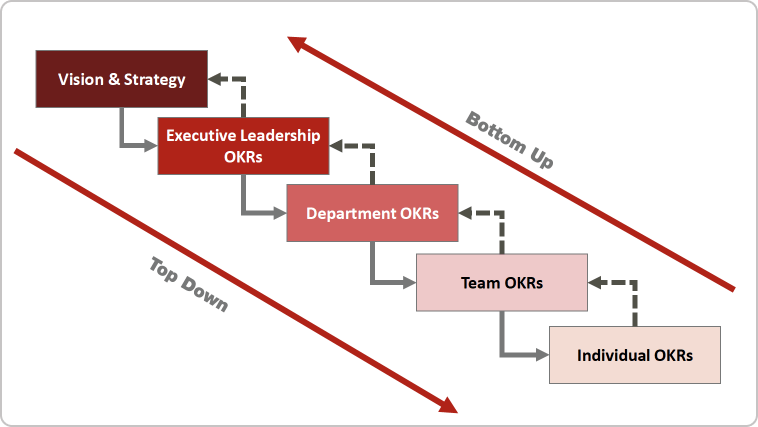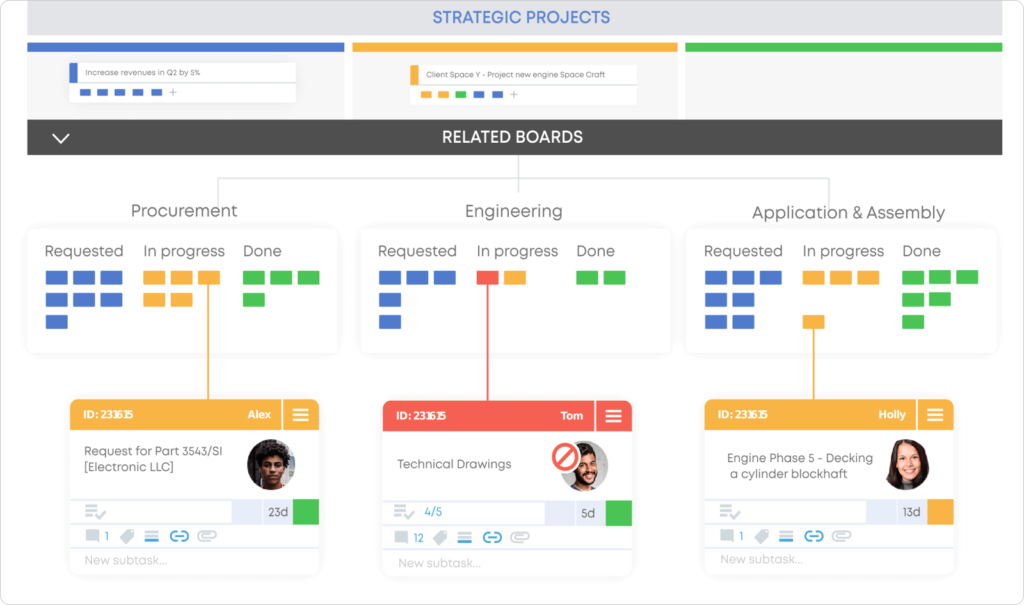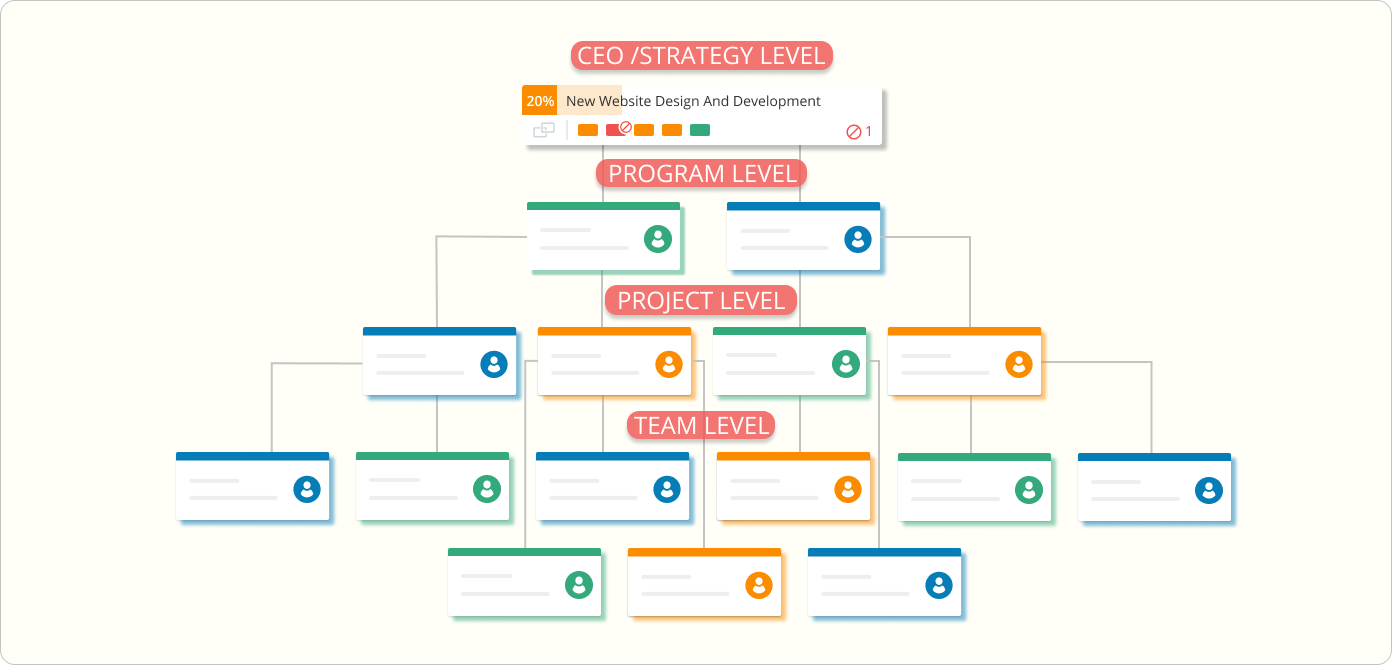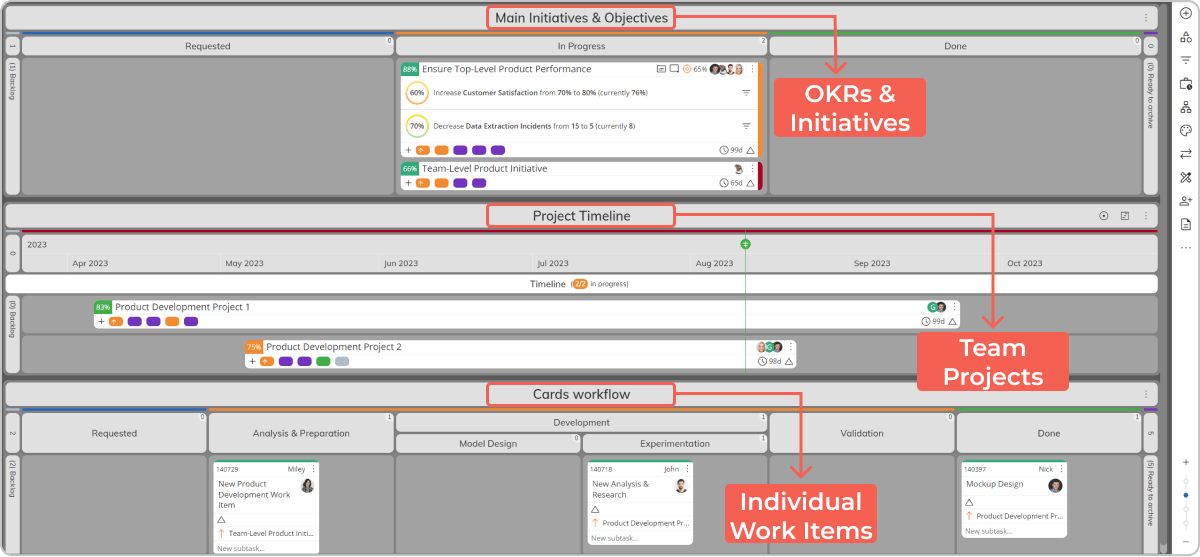While it’s true that OKRs and project management are two completely separate entities, it’s not uncommon for them to work together. In fact, that’s actually recommended if you’re looking to tie your organization's goals to their actual realization on the market.
The question is how to find common ground between them?
To answer it, let’s begin by understanding what OKRs and project management respectively aim to achieve.
OKRs and Project Management Explained
OKRs is a goal-setting framework that can help organizations or teams translate strategy into execution. To do that, you need to define grander goals (objectives) that are part of the company’s vision and measure progress toward achieving them through key results. You can set OKRs across different organizational levels based on your scenario and scale.
Project management, on the other hand, is about all actions and processes that ensure customers are getting the value they’re paying for. Of course, there are different aspects here, such as budget management, capacity planning, choosing what projects or programs to execute first (strategic portfolio management), etc. And still, they’re all related to ensuring successful delivery as efficiently as possible. If we shift the conversation to Agile project management, the idea of delivering maximum customer value through continuous improvement and feedback becomes even more prominent.

Stages of the Plan-Do-Check-Act (PDCA) model
Having said that, we can see a clear distinction here.
While the OKR framework deals with strategic goals and actions to measure them, it doesn’t tell you what teams should start working on or how to build their processes to achieve specific results. And that’s why project management is an important part of the equation.
In a nutshell, think of OKRs as setting your strategic goals, while project management is the daily actions you take to deliver them.
The Value of Combining OKRs with Project Management
Looking at some of the statistics, you will find that strategy execution is one of the most common challenges leaders face. In fact, recent research by Gartner indicates that about 40% of executive leaders are not aligned on strategy execution. And that’s not something new. Even though there are improvements, you will find that over the years, numerous publications have revealed data supporting this problem.
One of the most common reasons is ineffective project management and alignment. So, it’s clear that the problem is more about communicating the main business priorities and building the right processes to deliver them rather than creating a poor strategy.
And that’s exactly where the value of combining OKRs with effective project management practices lies. While having a framework to set strategic goals comprised of measurable key results is one part of the coin, the other is connecting them to actual team initiatives or individual work items.
How to Differentiate OKRs from Projects?
Besides the value of combing OKR and project management, it’s crucial that you understand how to distinguish them.
As discussed, OKRs is a framework that guides teams and ensures that all activities are aligned with the company’s strategy. However, oftentimes OKRs are considered as a to-do list, which is a wrong assumption and a leading cause for failed OKR adoptions. OKRs’ purpose does not correspond to the purpose of your project activities – simply completing a work item. They should not be treated as a checklist.
Let’s have a look at the following example and find out why this looks like an OKR, but actually, it isn’t.
Objective: Delight our customers
- Key Result 1: Send a “Welcome” email to all new customers
- Key Result 2: Submit customer satisfaction survey
- Key Result 3: Prepare a demo video
What is not right with these KRs? They fail to explain how the team will delight their customers. Looking at them, we see action items that will contribute to reaching the final goal and not inspirational outcomes showing the progress of the team’s efforts.
A better structure of the Key Results of this Objective could be:
- Key Result 1: Decrease response time from 2 hours to 1 hour
- Key Result 2: Decrease customer onboarding time from 4 sessions to 2 sessions
- Key Result 3: Customer support tickets are solved in 2 days
These are meaningful outcomes that would have a long-lasting impact on your service. Achieving those will surely move the needle to reach your goal of delighting your customers.
How to Build a Link Between OKRs and Delivery?
As we mentioned above, in the OKR framework, objectives are inspirational and grander goals, while the key results are the actions that measure whether you’re achieving them. Frankly, this thinking behind OKRs remains the same regardless of whether you set them on a company, departmental, or team level.
So, you can create quarterly OKRs on a company level that directly tie in with your company’s strategic vision. Then, it’s а good practice to cascade those OKRs across different business areas or individual teams (depending on your scale). In turn, team leaders or project managers can collaborate to set their own quarterly OKRs that support the higher-level ones.
 Creating OKRs across different organizational levels. Image Credit: People Stretch Solutions
Creating OKRs across different organizational levels. Image Credit: People Stretch Solutions
What’s missing here is the link to the actual projects that teams will be working on. To create it, you can come up with team projects and initiatives that drive the progress of different key results.
For example, imagine that you have an objective for your Engineering department to improve the quality of a digital product. One of the key results here could be reducing the system's bugs by a given percentage. A project that helps you deliver this key result (and respectively objective) could be to refactor the internal code structure of a major part of the software. Respectively, you can have a lot of tasks that team members continuously pull in progress to deliver the project.
Of course, everything depends on the context. Especially in larger organizations, it’s far from uncommon to have complex projects that span multiple teams or even departments. In this case, you can collaborate with leaders on a departmental level and set objectives where each key result is handled by a different team.
 Cross-team dependencies in project management
Cross-team dependencies in project management
Generally speaking, the idea is to create a complete structure that ties your goals with the actual delivery process so that teams can focus on the true business priorities. To keep this in check and align stakeholders, look to create regular OKR reviews. They’re essentially meetings you can combine with other feedback loops/cadences across different organizational levels.
Visualizing OKRs and Delivery Processes
Logically, the question now moves to how to create that structure in practice? A great way to start is to visualize what you currently have.
For example, you can put on display your current delivery processes and add another layer on top of them that represents your OKRs. Here, the Kanban method has a lot to offer thanks to its visualization principles. By using interconnected Kanban boards, you can visualize the flow of both your projects and individual work items. With this visualization, executive leaders can also create OKR Kanban boards and use them for mapping the flow of strategic objectives.
 Using multiple Kanban boards to visualize work across different organizational levels
Using multiple Kanban boards to visualize work across different organizational levels
Another approach is to divide your Team Kanban boards into multiple workflows that display your OKRs and delivery processes. Once again, it all depends on your context and the organizational level where you want to build your OKRs.
 Connecting team-level OKRs with projects and delivery processes
Connecting team-level OKRs with projects and delivery processes
Regardless of what your structure is, the important part is to grasp the concept. Using OKR software that allows having everything visualized in a single place, you can communicate your business priorities to the people responsible for the actual work. When the priorities become clear, project managers and teams can better plan what projects/initiatives to start working on that will have a true impact on the company’s strategy.
Examples of OKRs for Project Management
When talking about OKR examples for project management, you should know that virtually every process in the company is related to managing some type of projects. The only difference is that they might take various forms – fulfilling customer orders, building features, executing marketing campaigns, etc.
Still, you might decide to set OKRs specifically for a PMO (Project Management Office) department. Such a function might be valuable for your company when dealing with large portfolios of complex projects.
1. OKRs for Agile Project Management Transformation
| Objective |
Create a responsive and adaptive organization |
| Key Result 1 |
Deliver training on Agile values and principles to all organizational departments |
| Key Result 2 |
Integrate cadences/feedback loops to keep management and teams aligned on work initiatives |
| Key Result 3 |
Source and implement a proper digital tool to create a central system for work management |
2. OKRs for Project Timelines
| Objective |
Release value faster to customers |
| Key Result 1 |
Optimize processes to improve engineering project lead times by min. 20% |
| Key Result 2 |
Train engineers on using MVPs (Minimum Viable Products) to gather early customer feedback |
| Key Result 3 |
Keep engineering flow efficiency above 40% |
3. OKRs for Project Budget Management
| Objective |
Reduce development costs to increase profitability |
| Key Result 1 |
Re-negotiate conditions with project contractors to cut costs by 20% |
| Key Result 2 |
Evaluate project based on cost of delay |
| Key Result 3 |
Maintain budget variance below 40% |
We offer the most flexible software platform
for outcome-driven enterprise agility.
In Summary
Combining OKRs with project management can enable you to align your strategic goals with their delivery and ensure that you execute the most important business priorities. To do this in practice, you can:
- Cascade your OKRs to build a link between your goals and actual projects/initiatives
- Visualize the flow of both your OKRs and delivery processes
- Keep everyone aligned through various feedback loops across the company






 Creating OKRs across different organizational levels. Image Credit:
Creating OKRs across different organizational levels. Image Credit:  Cross-team dependencies in project management
Cross-team dependencies in project management  Using multiple Kanban boards to visualize work across different organizational levels
Using multiple Kanban boards to visualize work across different organizational levels Connecting team-level OKRs with projects and delivery processes
Connecting team-level OKRs with projects and delivery processes

